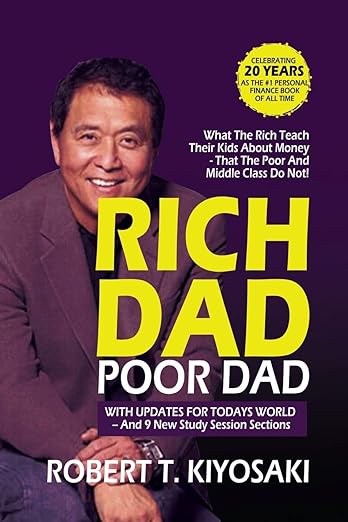Rich Dad Poor Dad Book Summary
“Rich Dad Poor Dad” by Robert Kiyosaki is a book that takes you on a journey through the contrasting financial philosophies of two father figures: the author’s biological father (referred to as “Poor Dad”) and the father of his childhood best friend (known as “Rich Dad”). Through this captivating narrative, Kiyosaki imparts valuable lessons on money, wealth-building, and the mindset required for financial success.
The story begins with the author reflecting on his upbringing, where he learned from two influential figures with drastically different perspectives on money. Poor Dad, a well-educated man with a stable job, believed in the traditional path of getting a good education, working hard for a steady job, and saving money. On the other hand, Rich Dad, a successful entrepreneur and investor, emphasized the importance of financial education, taking calculated risks, and building assets.
One of the book’s central themes is the distinction between assets and liabilities. Kiyosaki explains that assets are things that put money in your pocket. At the same time, liabilities take money out of your pocket. Rich Dad encourages the development of assets, such as investments and businesses, to achieve financial independence. This contrasts the conventional wisdom of simply working for a paycheck, which often leads to accumulating liabilities.
Throughout the book, Kiyosaki emphasizes the significance of financial literacy. He argues that schools focus on academic and professional skills but neglect to teach students about money and how it works. Rich Dad, recognizing this gap, becomes Kiyosaki’s mentor, imparting essential lessons on cash flow, investing, and the importance of making money work for you.
One key concept introduced by Rich Dad is the importance of entrepreneurship. He encourages Kiyosaki to think beyond the confines of a traditional job and consider creating his sources of income. Rich Dad believes that being an entrepreneur provides greater control over one’s financial destiny and allows for the creation of unlimited income streams.
The book also explores working to learn rather than working for money. Rich Dad advocates gaining valuable skills and knowledge through hands-on experience, even if it means initially working for little or no pay. This emphasis on continuous learning and personal development sets the foundation for long-term financial success.
Kiyosaki delves into the mindset required for financial success, emphasizing the importance of overcoming fear and taking calculated risks. He argues that many people are held back by the fear of failure, preventing them from pursuing opportunities that could lead to financial prosperity. Rich Dad’s lessons challenge the conventional belief that failure is something to be avoided and instead view it as a crucial aspect of the learning process.
The book also touches on the concept of the rat race, where individuals work tirelessly to cover their expenses but struggle to break free from the cycle of living paycheck to paycheck. Kiyosaki advocates for a shift in mindset, encouraging readers to focus on building assets that generate passive income, ultimately providing the financial freedom to escape the rat race.
One of the memorable quotes from “Rich Dad Poor Dad” is, “The poor and the middle class work for money. The rich have money work for them.” This encapsulates the core philosophy of the book, emphasizing the importance of creating financial systems that generate income independently.
In conclusion, “Rich Dad Poor Dad” by Robert Kiyosaki is a thought-provoking and eye-opening exploration of financial principles that challenge conventional wisdom. Through the contrasting perspectives of Poor Dad and Rich Dad, Kiyosaki provides readers with valuable insights into money, investing, and the mindset required for financial success. The book guides those seeking to break free from financial constraints, encouraging them to rethink their approach to money and take proactive steps toward building wealth. Whether you’re a seasoned investor or a financial novice, the lessons presented in this book have the potential to reshape your perspective on money and pave the way for a more secure and prosperous future.
